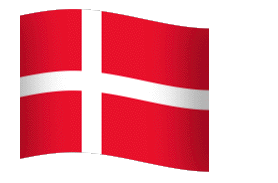Facts of Denmark
General facts:
-The population of Denmark is 5,5 million people.
-The official language is Danish but they also learn English and Deutsche.
-The currency is Denmark Kroner.
-The official religion is Christianity (90% protestants).
-The timezone of Denmark is the same than in Spain: UTC +1-The national letters on cars are DK.
-The international phone code there is +45.
-The number in case of emergency is: 112.
-The national bird of Denmark is the swan.
-The speed limits are: In the city: 50 km/h - Highway: 80 km/h - Freeway: 110 km/h.
-The life expectancy of Denmark is: Women 81.62 years, men 77.3 years (2012).
-The flag of Denmark is:

Geography facts:
The capital city in Denmark is Copenhagen, and other important cities with their population are: Aarhus 319.094 , Odense 168.798, Aalborg 126.556 (2012).
Denmark is divided in five areas, which are: Sealand, Jutland, Funen, Bornholm and The islands, Copenhagen is in Sealand.

The area of Denmark is about 43.098 km²
The population density is 126,4 per km²
Government facts:
The present Government consists of the parties Social Democrats, Social Liberals and Socialist People´s Party. Helle Thorning-Schmidt, from the Social Democrats is the Prime Minister.
The Kingdom of Denmark is a constitutional monarchy, in which Queen Margrethe II is the Head of state (since 14 January 1972).

This is a picture of the queen, the one in the middle, and the royal monarchy.
Denmark is part of Scandinavia and they are also a members of The European Union, UN, OECD, NATO and others.
Traditions:
-February/march - shrovetide: Shrovetide is a children’s festival, they dress up – usually on Quinquagesima Sunday – and go around with their collection tins which they try to get filled with money.
-April/May Great Prayer Day: Great Prayer Day is a special Danish festival falling on the fourth Friday after Easter Sunday, i.e. at the earliest on 17 April and at the latest on 21 May.
-5 May - Denmark's Liberation: After having been occupied by Germany since 9 April 1940, Denmark became free again on 5 May 1945. When the liberation was announced in the 8.30pm BBC broadcast on 4 May 1945, many Danes spontaneously placed lit candles in their windows. This became a custom that is still kept up by many Danes.
-5 June - Constitution Day: 5 June is the anniversary of the coming in force of the first Danish Constitution, the June Constitution of 1849. The day, which in many places is a full or half holiday, is celebrated around the country with political rallies, which especially formerly were in the nature of popular festivals, for instance on the popular nature spots Himmelbjerget and Skamlingsbanken in Jutland. It is also Father’s Day, which was introduced from the USA in 1935.
-31 December - New Year: Unlike Christmas, which most people spend with their family, New Year is celebrated with the friends. New Year’s Eve is framed by two important items broadcast on television and radio, viz. respectively the monarch’s New Year Speech at 6pm and the striking of midnight by the Town Hall Clock in Copenhagen, which marks the start of the new year.
The monarch’s New Year Speech has virtually become a national rallying point since it was first made in 1942 during the German Occupation, when the King called for national unity.
Other holidays days are: Labour Day and the day before Christmas Day (lille jule aften),the Christmas Day (Juledag) and the Second Christmas Day (2. Juledag), those are half holidays for most people.
Denmark is part of Scandinavia and they are also a members of The European Union, UN, OECD, NATO and others.
Traditions:
-February/march - shrovetide: Shrovetide is a children’s festival, they dress up – usually on Quinquagesima Sunday – and go around with their collection tins which they try to get filled with money.
-April/May Great Prayer Day: Great Prayer Day is a special Danish festival falling on the fourth Friday after Easter Sunday, i.e. at the earliest on 17 April and at the latest on 21 May.
-5 May - Denmark's Liberation: After having been occupied by Germany since 9 April 1940, Denmark became free again on 5 May 1945. When the liberation was announced in the 8.30pm BBC broadcast on 4 May 1945, many Danes spontaneously placed lit candles in their windows. This became a custom that is still kept up by many Danes.
-5 June - Constitution Day: 5 June is the anniversary of the coming in force of the first Danish Constitution, the June Constitution of 1849. The day, which in many places is a full or half holiday, is celebrated around the country with political rallies, which especially formerly were in the nature of popular festivals, for instance on the popular nature spots Himmelbjerget and Skamlingsbanken in Jutland. It is also Father’s Day, which was introduced from the USA in 1935.
-31 December - New Year: Unlike Christmas, which most people spend with their family, New Year is celebrated with the friends. New Year’s Eve is framed by two important items broadcast on television and radio, viz. respectively the monarch’s New Year Speech at 6pm and the striking of midnight by the Town Hall Clock in Copenhagen, which marks the start of the new year.
The monarch’s New Year Speech has virtually become a national rallying point since it was first made in 1942 during the German Occupation, when the King called for national unity.
Other holidays days are: Labour Day and the day before Christmas Day (lille jule aften),the Christmas Day (Juledag) and the Second Christmas Day (2. Juledag), those are half holidays for most people.
David Marti & Danís Azizov
No comments:
Post a Comment